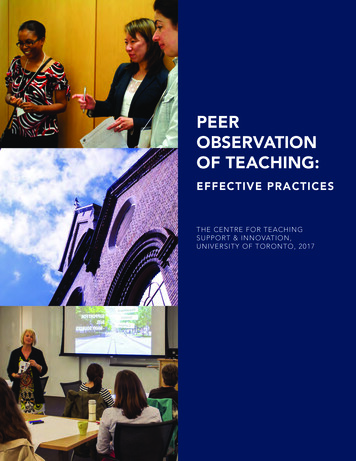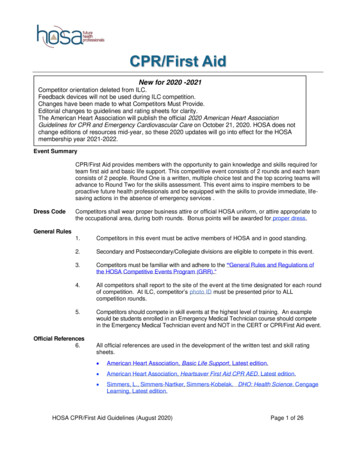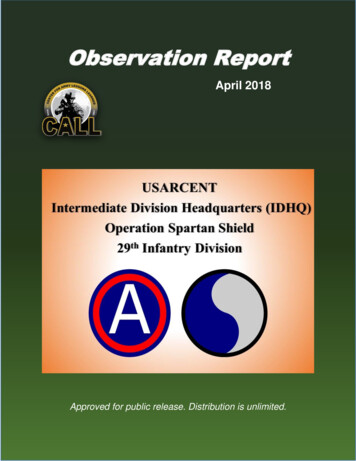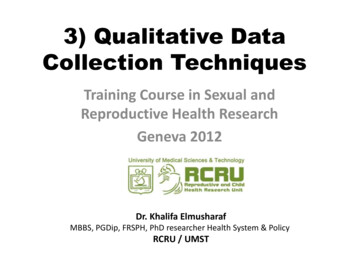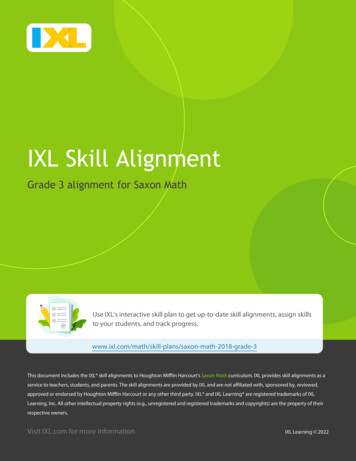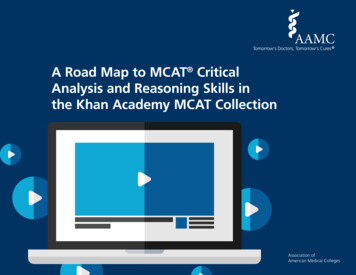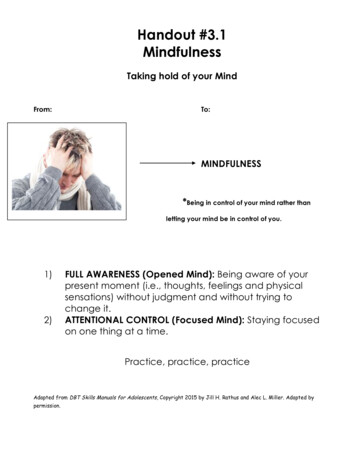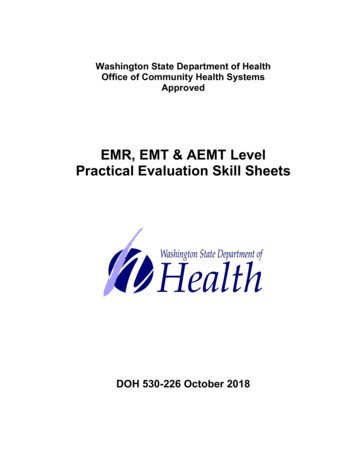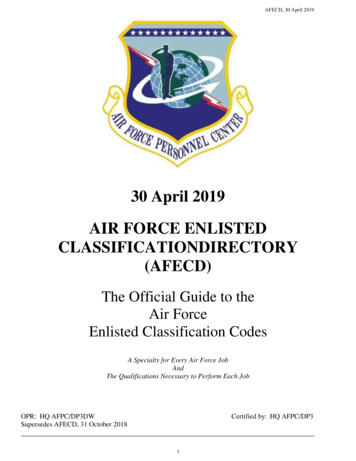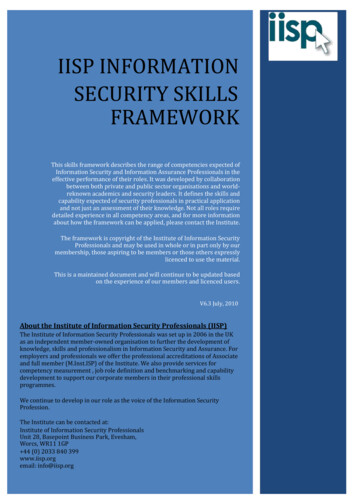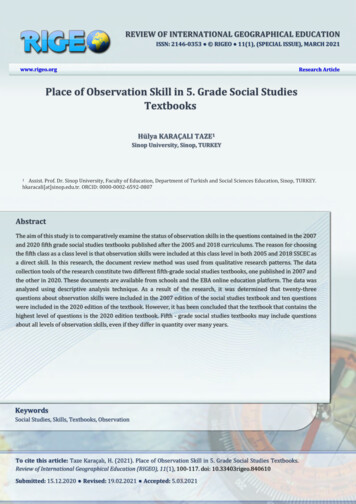
Transcription
REVIEW OF INTERNATIONAL GEOGRAPHICAL EDUCATIONISSN: 2146-0353 RIGEO 11(1), (SPECIAL ISSUE), MARCH 2021www.rigeo.orgResearch ArticlePlace of Observation Skill in 5. Grade Social StudiesTextbooksHülya KARAÇALI TAZE1Sinop University, Sinop, TURKEY1 Assist. Prof. Dr. Sinop University, Faculty of Education, Department of Turkish and Social Sciences Education, Sinop, TURKEY.hkaracali[at]sinop.edu.tr. ORCID: 0000-0002-6592-0807AbstractThe aim of this study is to comparatively examine the status of observation skills in the questions contained in the 2007and 2020 fifth grade social studies textbooks published after the 2005 and 2018 curriculums. The reason for choosingthe fifth class as a class level is that observation skills were included at this class level in both 2005 and 2018 SSCEC asa direct skill. In this research, the document review method was used from qualitative research patterns. The datacollection tools of the research constitute two different fifth-grade social studies textbooks, one published in 2007 andthe other in 2020. These documents are available from schools and the EBA online education platform. The data wasanalyzed using descriptive analysis technique. As a result of the research, it was determined that twenty-threequestions about observation skills were included in the 2007 edition of the social studies textbook and ten questionswere included in the 2020 edition of the textbook. However, it has been concluded that the textbook that contains thehighest level of questions is the 2020 edition textbook. Fifth - grade social studies textbooks may include questionsabout all levels of observation skills, even if they differ in quantity over many years.KeywordsSocial Studies, Skills, Textbooks, ObservationTo cite this article: Taze Karaçalı, H. (2021). Place of Observation Skill in 5. Grade Social Studies Textbooks.Review of International Geographical Education (RIGEO), 11(1),100100-117. doi: 10.33403rigeo.840610Submitted: 15.12.2020 Revised: 19.02.2021 Accepted: 5.03.2021
One of the courses in which the aim of educating individuals who are healthy andefficiently devoted to society and developing the abilities of these individuals(Güven, 2007) can be realized is the social studies course. 21. century, especially inrelation to talent development. skills have become more important in the centuryand 21. century the inclusion of skills described as skills in the curriculum is one ofthe important developments in the field of education. Skill is defined as” thepredisposition in students to be able to do a job or process a subject, which isdesigned to be acquired, developed and transferred to life in the learning process "(Ata, 2015, P 38). When examining the Social Studies course education curriculum([SSCEC], 2018), it is possible to see the characteristics of individuals who can adaptto society and develop their abilities within competencies, values and skills.However, skills are also among the basic elements of the SSCEC, which was preparedin accordance with the constructivist understanding in 2005. It is understood fromthe expression that at least one skill will be acquired in each learning area whereskills are important in social studies education.In 2018, updates were made to the SSCEC, and one of these updates is related toskills. In 2005 and 2018, the number of skills increased from fifteen in 2005 totwenty-seven in 2018. 2005 (Minestry of National Education, 2005, p. 47) the skillsincluded in the program in the year are as follows, and the first nine of them will begiven together with other courses, and the last six are skills specific to the socialstudies course:1.Critical thinking skills2.Creative thinking skills3.Communication skills4.Research skills5.Problem solving skills6.Decision making skills7.Ability to use information technology8.Entrepreneurial skills9.Ability to use Turkish correctly, beautifully and effectively10.Observation skill11.Ability to perceive place12.Ability to perceive time and chronology13.Ability to perceive change and continuity14.Social participation skills15.Empathy skillIn 2018 (MoNE, 2018, p. 9), the following skills are included in the program:1. Research2. Environmental literacy3. Perception of change and continuity4. Digital literacy5. Critical thinking6. Empathy7. Financial literacy8. Entrepreneur9. Observation101
RIGEO Review of International Geographical Education11(1), Special Issue, 202110. Map literacy11. Law literacy12. Communication13. Collaboration14. Notice pattern expression and prejudice15. Using evidence16. Decision making17. Location analysis18. Media literacy19. Perceive place20. self control21. Political literacy22. Problem solving23. Social involvement24. Drawing and interpreting tables, charts and diagrams25. Correct, beautiful and effective use of Turkish26. Innovative thinking27. Perceive time and chronologyAs can be seen from the lists above, almost all of the skills included in 2005 wereincluded in the curriculum in 2018, while some skills not included in 2005 wereincluded in the curriculum in 2018. One of the common skills in both the 2005 and2018 SSCEC is observation skill. Skills included in 2005 but not included in 2018 areskills to use creative thinking. But 2018 is not contained in 2005, located in sevenliteracy skills (environment, digital, financial, map, law, media, and politics),cooperation, expression and prejudice to notice, using evidence, location analysis,self-control, tables, graphs, and diagrams, drawing skills, and innovative thinkinginterpreting. One of the thirteen skills included in both programs is observation skill.However, the observation skill was only included in the fifth grade as a direct skillin 2005, while in 2018 the related skill is given at all grade levels within the “People,Places and environments” learning area. Although it is stated that the observationskill will be acquired at all grade levels of the relevant learning area in the 2018SSCEC, it is stated only in the fifth-grade learning area in the description of whichskill will be acquired under the learning areas. Therefore, both located in the samegrade level in programs due to the skill of comparison can be done, and few studieson this subject have been found (Taş, 2008; Yıldız, 2016; Ablak, 2017; Çelikkaya andKürümlüoğlu, 2017; Filoğlu, 2018; Kıbıcı, 2019) due to this skill is worth checkingout. For this reason, the aim of this research is to comparatively examine the statusof observation skills in the questions contained in the fifth-grade social studiestextbooks published in 2007 and 2020. Within the scope of this purpose, in theresearch process, we tried to look for answers to the following sub-problems;1. How is it that observation skills are included in the questions contained in thesocial studies textbook published in 2007?2. How is it that observation skills are included in the questions contained in thesocial studies textbook published in 2020?3. Social studies textbooks published in 2007 and 2020 what is the situationcompared to questions about observation skills.102
Taze Karaçalı, H. (2021). Place of Observation Skill in 5. Grade Social Studies TextbooksObservation is the examination of events and facts by different methods (MoNE,2005). According to the Turkish language institution (2020), observation is “carefuland planned consideration and examination of an object, event or fact in order toknow its qualities”. In both definitions, the work of examination comes to the fore.In order for this examination to be carried out, there must be a sense of curiosity.Observation skills can be improved by the sense of curiosity that exists in youngchildren (MoNE, 2005).There are some benefits to observing. These are listed below (Tan and Temiz, 2003): It leads children to be curious,By observing similarities and differences, classification, identification andmodification skills are developed,Observation of successive events helps to develop the concept,Enables development of information,It reveals his excitement for research.In order to improve the observation skills of students at the secondary schoollevel, it is necessary to focus mainly on “the ability to pay attention to events andphenomena around them, their awareness” (MoNE, 2005). Students who studyevents in the immediate vicinity have knowledge about the environment in whichthey are located (Demircioğlu and Akengin, 2012). Making observations in real lifein relation to the subjects learned in the classroom plays an important role inunderstanding what geography is, how it is used in daily life, and how it contributesto the solution of problems in the world (Üker, 2009).In the 2005 SSCEC, the observation skill is cascaded as follows: Attention to events and phenomena around itDetect events and phenomena around itAccurately and impartially identify events and facts around itExplain the causes and consequences of surrounding events and casesBe able to question the reasons and predict the consequences of what theyobserveAbility to establish relationships between events and phenomena, revealsimilar or different aspectsRecord and transmit what you observeAbility to compare and link what they observe with what they have learnedbeforeUse what they observe as data in research or to make plans for the futureAssociating with similar events and developing behavior about what to do whenfaced with such an event (MoNE, 2005, p. 50).2005 SSCEC “People, Places and environments” learning area fifth gradeachievements related to observation skills in the “Let's get to know our region” unitare listed below: He/She explains the impact of the climate seen in the region where he/shelives on human activities by giving examples from his daily life.103
RIGEO Review of International Geographical Education11(1), Special Issue, 2021 He/She associates geographical features with places where people in the areawhere they live extensively. He/She shows evidence of how people in the area where they live change anduse the natural environment. He/She Associates the geographical features of the region with a disaster seenin the area in which it lives. Based on the oral and written elements of our culture, it exemplifies the effectsof natural disasters on public life. He/She notices human activities that increase the damage of natural disastersseen in the area where he/she lives.It can be said that when the above attainments are examined, the situations thatrequire the student to observe their immediate environment are addressed and theapplications that correspond to the knowledge and understanding dimension of thecognitive field, such as giving an example, noticing the student, are included.2018 SSCEC “People, Places and environments” learning area achievementsassociated with observation skill in fifth grade are listed below:SS.5.3.2. He/She explains the impact of the climate seen in the environment inwhich he/she lives on human activities by giving examples from his daily life.SS.5.3.3. He/She gives examples of the natural features and effects of humanfeatures on population and settlement.The place where he/she lived and the vegetation of his surroundings aredescribed without going into detail.Factors affecting the distribution of the population are emphasized. Evidence isshown of how humans change and exploit the natural environment.SS.5.3.4. He/She questions the causes of disasters and environmental problemsin the environment in which he lives.SS.5.3.5. Explain the effects of natural disasters on public life with examples.(MoNE, 2018, p. 17-18).As with the attainments in 2005, the observation related to the immediateenvironment is given. But these achievements include practices that correspond tothe knowledge, understanding dimension of the cognitive field, such as giving anexample, explaining, as well as an application that should higher-level thinkingskills, such as questioning, to work.Studies on observational skill in social studies education were examined andstudies on teacher opinion (Yıldız, 2016) and student perception (Ablak, 2017;Filoğlu, 2018), teacher, student and parent opinion (Kıbıcı, 2019) and skill teaching(Taş, 2008) were found. Yıldız (2016) concluded in his study that MoNE resourcesare insufficient to acquire the relevant skills in line with the views of the teacher.Filoglu (2018), who conducted research on students in terms of field-specific skillsincluded in the 2005 Social Studies course curriculum, which also includedobservation skills, found that students can always perform these skills. In another104
Taze Karaçalı, H. (2021). Place of Observation Skill in 5. Grade Social Studies Textbooksstudy conducted on students (Ablak, 2017), student perceptions of field-specificskills were examined and as a result of the research, it was found that there are anumber of deficiencies in student perceptions related to these skills. A studyconducted on teachers, students and parents (Kıbıcı, 2019) concluded that the skillthat both teachers and students find most important in field-specific skills isobservational skill.A very limited number of studies have been found on observation skills, whichare one of the skills intended to be acquired in the social studies course and whichare included in both the 2005 and 2018 SSCEC. In addition, only one study on howthis skill, which is among the field-specific skills in the 2005 SSCEC, is included intextbooks (Çelikkaya and Kürümlüoğlu, 2017) is an important consideration. Butthis study is not a study specific to observation skills, it is aimed at how field skillsare considered in textbooks, and observation skills are also one of the skills studied.Therefore, the main purpose of the study is 2007 and 2020 edition fifth grade classare a comparative study of the status of observation skills in questions contained insocial studies textbooks.MethodologyModel of the ResearchIn this research, the document review method was used in accordance with thequalitative research approach. In the document review, written materials withinformation about the facts contained in the research are analyzed, and theauthenticity of the documents is an important consideration (Yıldırım and Şimşek,2008). However, textbooks on history and social issues can be the subject of studyin both social sciences and Educational Sciences (Ulutaş, 2017). Based on this, theresearch documents are published in two different 2007 and 2020. 5. grade in theclass is composed of textbooks and these documents were originally and originallydeveloped for the social studies course by a commission. These documents areavailable from schools and the EBA online education platform.Data Collection ToolsThe research was conducted by examining two different fifth grade textbookspublished in 2007 and 2020. The reason for selecting textbooks with 2007 and 2020editions in the study is that the SSCEC was changed in 2005 and 2018. The 2007edition book was chosen because it was the first book to be reached in print orelectronic form after the publication of this program, and the 2020 edition book waschosen because it was the most current book. The reason for choosing the fifth classas the class level is as a direct skill, observation skills were included at this gradelevel in both 2005 and 2018 SSCEC.The data collection tools of this research are MoNE publishing (Karagöz, Tekerek,Kaya, Azer, Alıç, Yılbat, Koyuncu and Ulusoy, 2007) and Ata publishing (Harut,2020).Data AnalysisDescriptive analysis technique was used in this study. To Bailey according to(1982, Ref. Yıldırım and Şimşek, 2008), researchers who will use textbooks as a data105
RIGEO Review of International Geographical Education11(1), Special Issue, 2021source can analyze research data using the stages of selecting samples from the datasubject to analysis, developing categories, determining the analysis unit, anddigitizing. In this research, four-stage data analysis was used as textbooks constitutethe data source. In the first stage, the sample was determined by selecting the classlevel, year and skill. In the second stage, it was determined that the skill should beincluded in the textbooks. In the third stage, as a unit of analysis, questions aboutthe ability to observe the questions were identified, and as a result of these analyses,the fourth stage, digitization, was performed. First, the frequencies of the questionsassociated with observation skills were determined in the questions. After accessingthe numerical data, it was attempted to determine the status of observing thequestions contained in the textbooks by calculating the percentage. It was thendetermined which step the questions were aimed at the observation skill. Thesesteps were created by the MoNE (2005) and are listed below:1. Attention to events and phenomena around it.2. Detect events and phenomena around it.3. Accurately and impartially identify events and facts around it.4. Explain the causes and consequences of surrounding events and cases.5. Be able to question the reasons and predict the consequences of what theyobserve.6. Ability to establish relationships between events and phenomena, revealsimilar or different aspects.7. Record and transfer what you observe.8. Ability to compare and link what they observe with what they have learnedbefore.9. Use what they observe as data in research or to make plans for the future.10. Associating with similar events and developing behavior about what to dowhen faced with such an event.Finally, the two textbooks are compared in terms of questions aimed atattainment observation skills. The researcher can ensure the reliability of theresearch by enriching it with direct citations (Yıldırım and Şimşek, 2008); therefore,direct references of parts of the textbooks containing the ability to observe areincluded.FindingsFindings About the First Sub-ProblemIn the social studies textbook published in 2007 under this heading, questionsand levels asked about an attainment observation skill are given.Below are images and levels of questions about observation skills in the 2007published social studies textbook. The images numbered in the table will bediscussed in detail later. In the textbook, questions about observation skills arefigurely named in the table, as they are given in figure form. This is because there106
Taze Karaçalı, H. (2021). Place of Observation Skill in 5. Grade Social Studies Textbooksare parts where there is more than one problem, and these parts are addressedtogether.Table 1Images and Levels with Questions about Observation SkillsGrade/FigureGradeAttentionto eventsandphenomena arounditGradeDetecteventsandphenomena arounditGradeAccurateandimpartialidentification ofsurrounding eventsandphenomenaGradeExplain thecauses andconsequencesof surroundingevents andcases6. GradeAbility to establishrelationshipsbetween events andphenomena, revealsimilar or differentaspectsFigure 1Figure 2Figure 3Figure 4Figure 5Figure 6Figure 7Figure 8Figure 9Total111114310111341111811As shown in Table 1, Six questions in figure 1 are one second level, one third level,and four fourth level; three questions in figure 2 are one first level, one second level,one third level; a fourth level question in figure 3; a fourth level question in figure 4;a fourth level question in figure 5; a fourth level question in figure six, a second levelquestion in figure 7; four second level questions in figure 8 and three second levelquestions in figure 9, a third level question.Figure 1. (Karagöz at. Al., 2007, p. 71)When questions related to figure observation skills were examined, it wasconcluded that the first question was related to the second level, the second questionwas related to the fourth level, the third question was related to the fourth level, thefourth question was related to the third level, the fifth question was related to thefourth level, and the sixth question was related to the fourth level. He/ she also said,107
RIGEO Review of International Geographical Education11(1), Special Issue, 2021" What are we going to learn? it seems that these six questions addressed under theheading "are questions aimed at revealing students' preliminary knowledge. In thisway, it will be possible to determine what students know based on theirobservations and to make more observations by arousing curiosity about what theywill learn within the unit.Figure 2. (Karagöz at. Al., 2007, p. 72)When the questions related to the observation skill contained in the figure twowere examined, it was concluded that the first question was related to the first level,the second question was related to the second level, the third question was relatedto the sixth level, and the fourth question was related to the third level. Here are thequestions at the beginning of the unit, and it was desired to measure both thepreliminary information and increase their interest in the course by drawing theattention of the students with the figures. Students were asked to establish arelationship between their observations and the situations found in the figure andasked questions about the highest level of observation skills contained in the 2007published book.Figure 3. (Karagöz at. al., 2007, p. 75)108
Taze Karaçalı, H. (2021). Place of Observation Skill in 5. Grade Social Studies TextbooksWhen the question associated with the observation skill in the figure third wasexamined, it was concluded that it was related to the fourth level. Here, studentswere asked a question that they had to answer to work on their observations of asituation in their immediate vicinity to measure whether they understood theinformation provided.Figure 4. (Karagöz at.al., 2007, p. 79)When the question associated with the observation skill in the figure quadrantwas examined, it was concluded that it was related to the fourth level. Here, studentswere asked a question to measure their prior knowledge and asked to give answersbased on their observations.Figure 5. (Karagöz at. al., 2007, p. 79)When the question associated with the observation skill contained in the figurefifth was examined, it was concluded that it was related to the fourth level. Studentsshould answer this question based on their observations other than the informationprovided.Figure 6. (Karagöz at. al., 2007, p. 83)When the question associated with the observation skill contained in the figurefifth was examined, it was concluded that it was related to the fourth level. Studentsshould answer this question based on their observations other than the informationprovided.Figure 7. (Karagöz at. al., 2007, p. 86)109
RIGEO Review of International Geographical Education11(1), Special Issue, 2021When the question associated with observation skill in figure seven wasexamined, it was concluded that it was related to the second level. Here, studentsare asked a question aimed at revealing their preliminary knowledge.Figure 8. (Karagöz at. al., 2007, p. 88)When the questions related to the observation skill contained in the figure eightwere examined, it was concluded that all the questions were related to the secondlevel. Here, students were asked to give examples based on their observations of theenvironment in which they lived, presenting an example to determine whether theyunderstood the information provided.Figure 9. (Karagöz at. al., 2007, p. 89)110
Taze Karaçalı, H. (2021). Place of Observation Skill in 5. Grade Social Studies TextbooksQuestions related to the observational skill contained in the figure nine areexamined: “How does the region in which you live affect the country's economy?"ithas been concluded that all other questions are related to the second level and thequestion is related to the third level. As mentioned earlier in this study, which is acontinuation of the previous study, it was attempted to measure whether theyunderstood the given information.Findings About the Second Sub-ProblemIn the social studies textbook published in 2020 under this heading, the questionsand levels asked about attainment observation skills are given.Below are images and levels of questions about observation skills in the socialstudies textbook published in 2020. The images numbered in the table will bediscussed in detail later.Table 2Images and Levels with Questions about Observation SkillsGrade/GradeGradeGrade4. GradeFigureAttention DetectAccurately Explain theto events eventsandcausesandandandimpartiall consequencesphenome phenome y identify ofnanaevents and surroundingaround it around it factseventsandaround ure15Figure16Figure17Total9. GradeUsewhattheyobserve as data inresearch or to makeplans for the future---1--11----1-------11--11-1------1-13132In the figure, as shown in table two fourth-level question; Figure eleven in a thirdlevel question, as shown in figure at twelve, a second-level question; at the front endfigure a second-level question; a question of the ninth level of the front quarterfigure; the figure at fifteen first-level question, fourth-level question, the ninth-levelquestion, figure Sixteen in a second-level question, and the fourth in the front sevenfigure level of a question is located.111
RIGEO Review of International Geographical Education11(1), Special Issue, 2021Figure 10. (Harut, 2020, p. 66)When the question associated with the observation skill contained in the figurewas examined, it was concluded that it was related to the fourth level. Here, aquestion was asked to measure students ' preliminary knowledge.Figure 11. (Harut, 2020, p. 74)When the question related to the observation skill contained in Figure Eleven wasexamined, it was concluded that it was related to the third level. In this question, anattempt was made to determine the preliminary information obtained by studentsbased on their observations.Figure 12. (Harut, 2020, p. 77)When the question associated with the observation skill contained in Figuretwelve was examined, it was concluded that it was related to the second level. Here,students were asked to think, taking into account the information given at the endof the subject, and express their thoughts by using observations and the informationthey learned in the course.Figure 13. (Harut, 2020, p. 78)When the question associated with the observation skill contained in the figureThirteen was examined, it was concluded that it was related to the second level.Here, students' views on a situation in the immediate area were taken to measureboth their preliminary information and draw attention to the subject.112
Taze Karaçalı, H. (2021). Place of Observation Skill in 5. Grade Social Studies TextbooksFigure 14. (Harut, 2020, s. 79)When the question associated with the observation skill in Figure fourteen wasexamined, it was concluded that it was related to the ninth level. Here is one of thehighest-level questions about the ability to observe in both books. Students can alsodevelop suggestions by using the knowledge learned in the course when answeringthis question.Figure 15. (Harut, 2020, s. 81)When the questions related to the observation skill contained in figure fifteenwere examined, it was concluded that the first question was related to the fourthlevel and the second question was related to the first and ninth levels. As can be seenfrom the title “I practice what I have learned” here, students should answerquestions using both their observations and the knowledge attainmented in thecourse. However, both books contain another of the highest-level questions aboutthe ability to observe.Figure 16. (Harut, 2020, p. 82)When the question associated with the observation skill contained in figuresixteen was examined, it was concluded that it was related to the second level. Here,a question was asked to measure students ' preliminary knowledge.113
RIGEO Review of International Geographical Education11(1), Special Issue, 2021Figure 17. (Harut, 2020, p. 84)When the question associated with the observation skill contained in figureseventeen was examined, it was concluded that it was related to the fourth level. Asthe word “other” implies here, students were asked to share the information theyattainmented based on their observations in addition to the information theylearned in the course.Findings about the Third Sub-ProblemUnder this heading, Social Studies textbooks published in 2007 and 2020 includea comparison of the questions they ask to gain observation skills.Table 3Question Numbers on Observation SkillYearQuestion200723202010According to table three, twenty-three questions about observation skills areincluded in the 2007 edition of the social studies textbook, and ten questions areincluded in the 2020 edition of the textbook. Accordingly, compared to the 2020edition textbook, more questions about observation skills were included in the 2007edition textbook.Table 4Questions About Observational Skill LevelsGrade/Year2007Grade2. GradeGradeGrade6. Grade9. 13210%10,030,010,030,020,0100,0According to Table 4, 1 of the 23 questions (4.3%) related to observational skillcontained in the 2007 published social studies textbook. Grade 2 (43.5%) Grade 3(13.1%) out of 3. Grade 4 (34.8%) out of eight 6. Grade and one (4.3%). It has beendetermined to be Grade. In the 2020 edition social studies textbook, 1 out of 10Questions (10.0%). Grade, 2 of three (30.0%). Grade 3 (10.1%) Grade, 4 of three(30.0%). Grade 9 (20.0%) It has been concluded that it is Grade. According to this,in the 2007 published textbook, no more than 2. To ask you to remove the part, atleast 1. and 6. Grade question; In the 2020 edition textbook, the maximum is 2. and114
Taze Karaçalı, H. (2021). Place of Observation Skill in 5. Grade Social Studies Textbooks4. Grade, at least 1. and 3. It was found that the question was included in the grade.As a Grade, it is seen that the textbook that contains the question at the top grade
Place of Observation Skill in 5. Grade Social Studies Textbooks Hülya KARAÇALI TAZE1 Sinop University, Sinop, TURKEY The aim of this study is to comparatively examine the status of observation skills in the questions contained in the 2007 and 2020 fifth grade social studies

